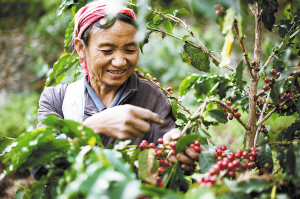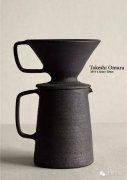Yunnan Coffee and Chinese Coffee Market
Coffee trees need high altitudes, tropical climates, and fertile soil to grow the best coffee beans. Such climatic conditions on the earth around the equator, probably between 25 degrees north latitude-30 degrees south latitude, this zone, generally known as the golden coffee belt, belongs to the tropical and subtropical regions, professional terminology called "coffee belt."
Let's talk about coffee in China first. According to the above definition, although China has a large territory and abundant resources, there are not many places where coffee can be grown. Apart from Hainan and Taiwan, parts of Yunnan, Guangdong and Guangxi, and the southern mountainous areas of Fujian, agriculture is also a habit, so there is no soil for coffee in the land under the small-scale peasant economy. Although many publicity materials now say where coffee is grown and how much coffee is produced. Strictly speaking, the domestic coffee industry is basically blank and almost can not be blank again.
To say coffee in China, we must first say coffee in Yunnan. Overseas coffee development has experienced three waves of instant coffee, Starbucks and fine coffee in World War II, but China's coffee development has experienced four waves.
Coffee in Yunnan began in 1892. French priest Tian De wanted to drink coffee but could not get it. So he brought some coffee seeds to the church of Zhukula Village Committee in Pingchuan Town, Binchuan, Dali, and began to plant the first coffee in China. Unfortunately, because of inconvenient transportation, coffee did not flow to more places at that time. Fortunately, because of inconvenient transportation, more than 1000 bourbon and tibeka trees were lucky to be handed down after more than 100 years. Two years ago, I heard that people in the coffee industry would start to go on pilgrimage. I think it should not be far from destroying it. Zhukula Village has been self-planting and self-baking for one hundred years. It should also be the dream of young people on the Bund of Shanghai after making money. There is coffee but no red, nothing strange in Yunnan.
Then, several decades later, in the middle and late stages of the War of Resistance Against Japan, Yunnan became the rear area. A large number of wealthy overseas Chinese from Southeast Asia brought their anti-Japanese ideals and coffee to Yunnan. After finishing production and work, they went to coffee shops. Some Wen Qing wrote a poem for the beautiful Vietnamese shop owner,"The old country is sad, the southern Xinjiang is lazy to make up, the eyebrows are condensed and tears are turned around, the worries are facing the world, and there is no language to talk about vicissitudes." The coffee culture of this series is a bit special, that is, adding something else while frying coffee, such as cream (and later a branch of white coffee). Overseas Chinese in Malaysia are idealists. If they have some money, they should do something for this country, otherwise they will feel sorry for their ancestors. Later, in the early 1950s, this group of idealists went to Hainan Xinglong, another coffee-producing place in China, because Zhou Enlai said that the coffee in this place was better than that in other places, deceiving Hainan people who were full of ideals and then planted coffee for decades. Anyway, although the result is not very good, at least this stage let the Chinese know that we can actually grow coffee.
Ten years ago, people started calling Yunnan coffee Arabica coffee, a hybrid of Arabica called katim, originally introduced to China by Nestle. Katim is not a variety with obvious style. Nestle sells commodities rather than characteristics, so Katim, which has good rust resistance and bad taste, has been vigorously promoted in Yunnan, and until today, Yunnan coffee prices are still subject to Nestle. On the other side of the Pacific Ocean, the same coffee variety was promoted and named Colombia. Coffee trees all over the world were sick, but Colombia achieved the second largest coffee industry in the world with this variety alone. It is said that people have different lives. It turns out that the same tree can also have different lives. Yunnan, Hainan, Vietnam, these three south is still in the edge of coffee in the old era of reflection stage. Another branch of the story is that the Taiwanese introduced Yunnan species to Alishan. After several years of hard work, last year's Fine Coffee Cup won the middle-aged year award. Last year, it ranked eighth in the world and the top in Asia.
When coffee is the same all over the world, you need to find something different.
Related in-depth reading:
Yunnan Coffee Green Bean Price in 2015: www.brst.cn/news/kfzx/722.html
[Coffee Roasting] Colombia Fine Coffee Bean Classification: www.brst.cn/news/kfzx/688.html
[Boutique Coffee] Market Prospect of Home Coffee Roasting: www.brst.cn/news/kfzx/679.html
Green Coffee Price vs. Retail Coffee Price: www.brst.cn/news/kfzx/618.html
How to operate a boutique coffee roaster: www.brst.cn/news/kfzx/547.html

Important Notice :
前街咖啡 FrontStreet Coffee has moved to new addredd:
FrontStreet Coffee Address: 315,Donghua East Road,GuangZhou
Tel:020 38364473
- Prev

Ethiopian cooperatives introduce African boutique coffee beans
Production area of Sigiga Cooperative (1600-2500 m): Gedeo-Kochere Cochel members: 1862 people Land attribute: red Brown soil Certificate: Fair Trade Fair Trade, UTZ Sustainable cultivation, Organic Organic Coffee Finchewan Cooperative (1450-2000 m) production area: Gedeo-Wenago Vina members: 1271 people Land attribute: reddish Brown
- Next

Understand the coffee culture and development in Australia
Coffee is everywhere in Australia, and the Australian nation is also one of the most coffee-loving nations in the world. They even think they love coffee more than anyone else. Australia's coffee culture is not only the upper-class play of the petty bourgeoisie in the center of the city, nor is it just a business game for tourists along Australia's golden coastline, it permeates the towns dotted all over Oceania.
Related
- Why can American refills for free? The difference between Americano and American drip pot coffee
- Being chased out of the rain in front of Starbucks?! Store: Sheltering from rain under umbrellas poses a safety hazard
- The white moonlight has changed?! Lucky launches "Big Winter Pear American"
- Hand-brewed coffee three-stage method, high-sweet and universal brewing method to share! What does the high sweet water level of hand-brewed coffee mean?
- What is the difference between raw, refined and full espresso coffee? How to extract espresso and taste good?
- A complete list of coffee bean names and their meanings! What is Yejia Shefi coffee? Where is Mantelin coffee?
- What grade does Arida Manor Kaduai coffee beans belong to? What treatment is Arida ASD slow anaerobic sun exposure?
- The milk tea cup becomes smaller?! Overlord Tea Girl launches a new "Return to Yunnan" series
- Accused of selling counterfeit and high-priced coffee beans! Well-known boutique coffee brand "Oukelao" bowed and apologized!
- How to make espresso dumplings? Can I eat coffee and glutinous rice balls together?

